
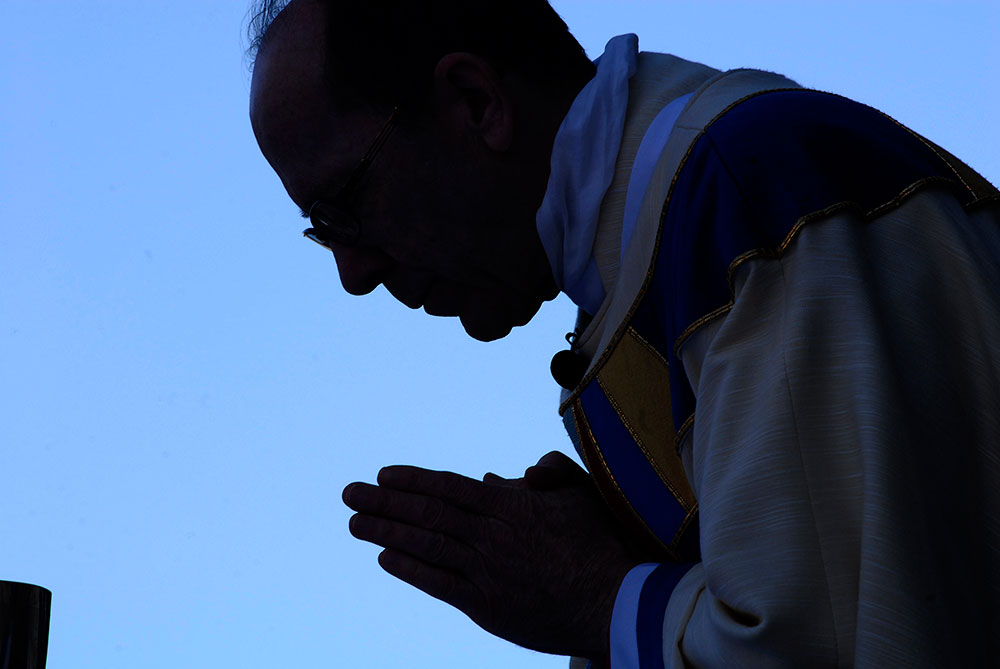
On a typical evening, Bishop Thomas J. Olmsted will make his way to the rectory chapel and pray vespers by himself, silently before the Lord. The bishop kneels using a meditation bench and, since he’s praying shortly before supper, his tummy rumbles.
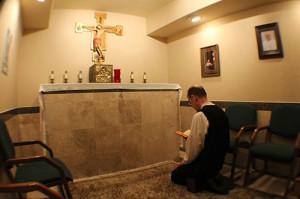
The bishop’s prayer life hasn’t drawn much fanfare, but he defines himself much more by it than by anything he’s done over the last decade. Dec. 20 marks the 10th anniversary of the bishop’s installation as the shepherd of the Diocese of Phoenix.
The Holy See appointed the bishop to Phoenix on Nov. 25, 2003. He had been serving as the bishop of the Diocese of Wichita, Kan. Before he left, he granted an interview to The Catholic Advance, the Wichita diocesan newspaper.
“I really don’t know why I was asked,” the bishop said of being appointed to Phoenix. “I think it would be linked with the fact that the Diocese of Wichita is a really good diocese. And because of that, it looks like I’m doing OK as a bishop.”
Bishop Olmsted packed up his few belongings into his compact car and drove himself to Phoenix. He moved from the bishop’s residence in Wichita to a room at the rectory at Ss. Simon and Jude Cathedral.
“He’s a faithful son of the Church. That means he oftentimes has to stand against the culture,” Fr. Peter Dobrowski, pastor of St. Margaret Mary Parish in Bullhead City, said of the bishop. “The media gives him a hard time because they’re scared of him. He stands for the truth, for what’s right.”
On Nov. 26, the bishop had a quiet dinner with Fr. John Lankeit, the cathedral rector, and Fr. Lawrence Urbaniak, a retired priest that helps out at the cathedral.
When Fr. Urbaniak arrived, the bishop received him and the two chatted about the priest’s service in the Diocese of Rockford, Ill. The priest, who has a doctoral degree, is an expert at counseling psychology.
“He’s a great help to us,” the bishop said. Before the meal, the priests stood behind their chairs as the bishop led the table in prayer. Once seated, Fr. Lankeit served the bishop a salmon fillet — the bishop requested one of the smaller pieces. He drank room-temperature water out of a yellow mug.
The atmosphere at the table was jovial, with the priests exchanging jokes and stories from the day. After the meal, they again stood behind their chairs and thanked the Lord.
The bishop feels called to community life — which is why he’s eschewed the bishop’s residence and chose to live in a little room at the cathedral rectory. He wants to be in a constant relationship with others.
Background
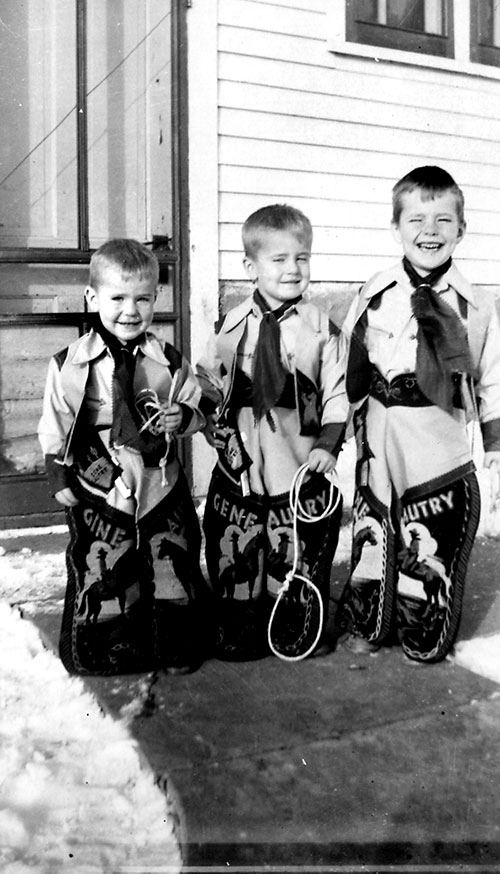
Bishop Olmsted grew up on a farm on the Kansas-Nebraska border. The family would heat up Sears Roebuck catalogs on the stove and use them to keep their feet warm in their beds as they fell asleep.
He and his five brothers and sisters played a major role at their “simple, tiny, little mission church,” sometimes making up half of the choir and serving at the altar.
Books on Blessed Miguel Pro and St. Thomas Aquinas inspired the bishop in his pursuit of the priesthood as a child. Nevertheless, he dated in high school.
“I always thought seriously about being a priest, so it wasn’t serious dating toward marriage,” said the bishop, noting that he was one in a graduating class of 17. “It was enjoying being around girls and especially going to the dances and things.”
He and his family love to dance.
The bishop was ordained a priest on July 2, 1973, for the Diocese of Lincoln, Neb. and joined the Jesus Caritas priestly fraternity shortly thereafter. Blessed Charles de Foucauld, a French priest who lived in the Sahara and sought to be a brother to all, inspired the fraternity.
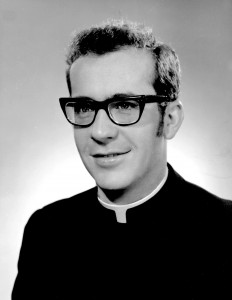
Bishop Olmsted served as an associate pastor at the cathedral in Lincoln for three years and then went to Rome for doctoral studies at the Gregorian. The bishop served as assistant to the Secretariat of State of the Holy See and assistant spiritual director at the Pontifical North American College in Rome for nine years after his doctoral studies were complete.
He met his best friend, Bishop Felipe de Jesús Estévez of St. Augustine, Fla., while studying in Rome. The two began praying the rosary together in French using a booklet that contained what would later become the Luminous Mysteries.
“We’ve remained close friends ever since,” Bishop Olmsted said. On his desk, the bishop has a photograph from Bishop Estévez’s episcopal ordination. It captures the moment when Bishop Olmsted, as a co-consecrator, laid his hands on his friend as God lifted him to the order of bishop.
Bishop Estévez, a Cuban refugee, noted Bishop Olmsted’s relationship with his family in particular as well as his love and knowledge of the teachings of Blessed John Paul II.
“He knows deeply the pontificate of John Paul II and its universal scope,” Bishop Estévez said. “The protection of the unborn and the whole culture of life, the family and the proclaiming of the Gospel of Christ to the world, are highlights in his leadership — he’s a very thin man, but a powerful leader.”
When Bishop Olmsted returned to the United States, he took a six month sabbatical at a Benedictine monastery in Conception, Miss., before beginning parish ministry.
“It was a way of letting go of everything in Rome to come back,” the bishop said. He spent two hours a day studying about Native Americans and did a three-week study on Martin Luther King, Jr.
From his parish, the bishop was appointed to the Pontifical College Josephium in Columbus, Ohio, where he served as dean of personal formation before being named the rector. He was ordained as coadjutor bishop of the Diocese of Wichita in 1999.
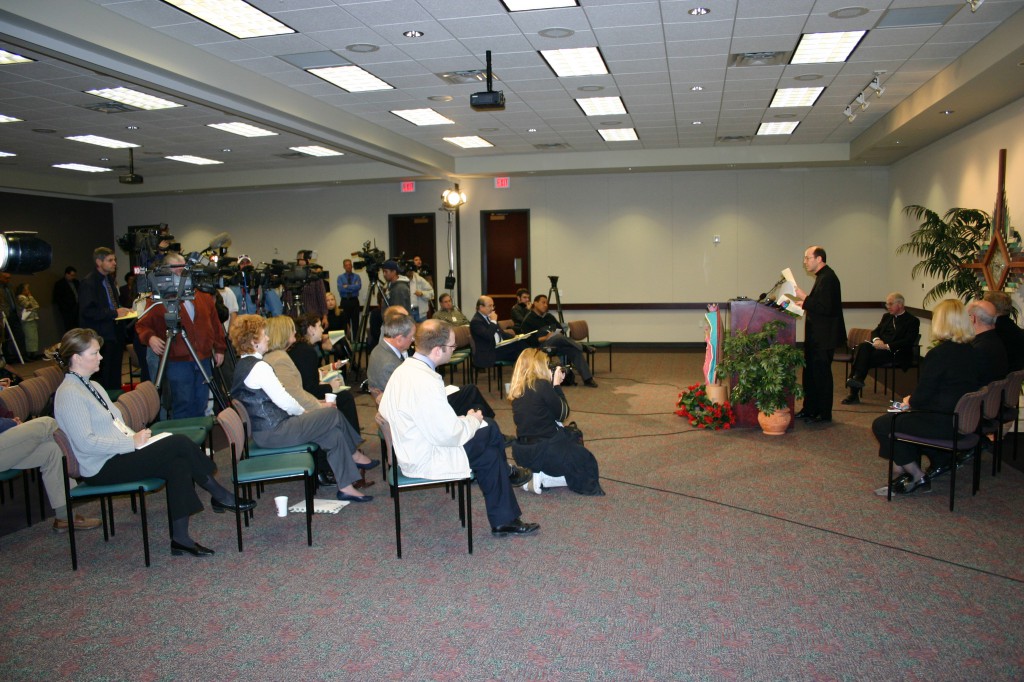
Appointed to Phoenix
When the Holy See appointed Bishop Olmsted to Phoenix, his predecessor, Bishop Thomas J. O’Brien, was facing charges for fleeing the scene of a fatal car accident. He resigned days after that incident.
Earlier in the year, Bishop O’Brien signed an agreement with the Maricopa County Attorney’s office in which he admitted to protecting priests accused of sexual indiscretions with children.
In his installation homily, Bishop Olmsted said that Christ’s transformative love “impels us to face the scandal of child abuse squarely and to combat it with honesty and determination.”
The Diocese of Phoenix has rigorously implemented the U.S. bishops’ Dallas Charter, which outlines how dioceses are to handle sexual abuse. Bishop Olmsted meets with victims, presides over healing Masses and acts quickly when accusations come forward.
Such was the case with Dale Fushek. When accusations came forward against the priest, then pastor of St. Timothy Parish in Mesa, the bishop placed him on administrative leave in accordance with the U.S. bishops’ charter.
The diocesan website publishes community notification statements whenever a credible accusation comes forward against a priest. Fushek was later excommunicated and laicized for leading a schismatic ecclesial community.
Bishop Olmsted believes it’s his duty “to bear witness to the Church and to defend the Church’s teaching,” he said. “A bishop is to be a father and a brother to his priests. To me that means that truth and love have to come together.”
Shortly after his installation, the bishop privately asked priests in the diocese to remove their names from “the Phoenix Declaration,” a public statement organized by the group No Longer Silent and signed by Christian clergy in support of “gay, lesbian, bisexual and transgendered persons.” He wrote each priest a separate letter.
“I asked them to remove their names from that list and to come in to see me and talk to me about it. And within 48 hours or so, it was publicly known, so it changed that aspect of it,” the bishop said.
“When there’s something that doesn’t seem to come together with the truth of the teachings of the Church, we have to have a conversation about that,” he said. “It’s best done privately or confidentially, so that was my hope.”
The bishop also hoped to deal privately with Sister of Mercy Margaret McBride, who authorized an abortion at St. Joseph’s Hospital and Medical Center in November 2009.
“I felt it was important for me to let sister know that it seemed to me that she had incurred an excommunication,” the bishop said, referring to Canon 1398, which states that those who participate in an abortion incur an automatic excommunication.
The bishop told Sr. Margaret how to have the excommunication lifted, but the matter did not remain private. Instead it is arguably what the bishop is most recognized for nationally — the so-called “Phoenix case.”
Sr. Margaret was part of an ethics committee that authorized an abortion for a woman that was 11-weeks pregnant and suffered from pulmonary hypertension. The hospital said the condition carried a near-certain risk of death for the mother if the pregnancy continued.
St. Joseph’s Hospital argued that the abortion was legitimate because, “We saved the only life we could,” that of the mother. The bishop, who has been supported in his decision by the U.S. bishops’ Committee on Doctrine, affirmed the Church’s teaching that the direct killing of an unborn child is never morally licit.
This impasse led to the bishop declaring that St. Joseph Hospital was no longer Catholic. The bishop said health care issues have been the toughest challenge he’s faced during his time in Phoenix.
“I think dealing with Catholic health care has been difficult, frustrating, disappointing. We have a great need for Catholic health care that really incorporates the Ethical and Religious Directives of the Church,” he said, referring to a set of guidelines established by the U.S. bishops. “I haven’t succeeded in achieving what I think is needed in the Church in that regard.”
The bishop was somber as he spoke about this. The U.S. Department of Health and Human Services contraceptive mandate, which is part of the Affordable Care Act, presents new challenges.
He doesn’t see a strong effort in Catholic health care in the diocese going forward, though he did commend the end-of-life care at Americare Hospice.
“I can understand why that would be extremely painful,” Sr. Jean Steffes, former chancellor of the Diocese of Phoenix, said of the conflict with St. Joseph’s Hospital. “He consulted widely and he took a long time in negotiations before he realized the problem wasn’t going to be resolved.”
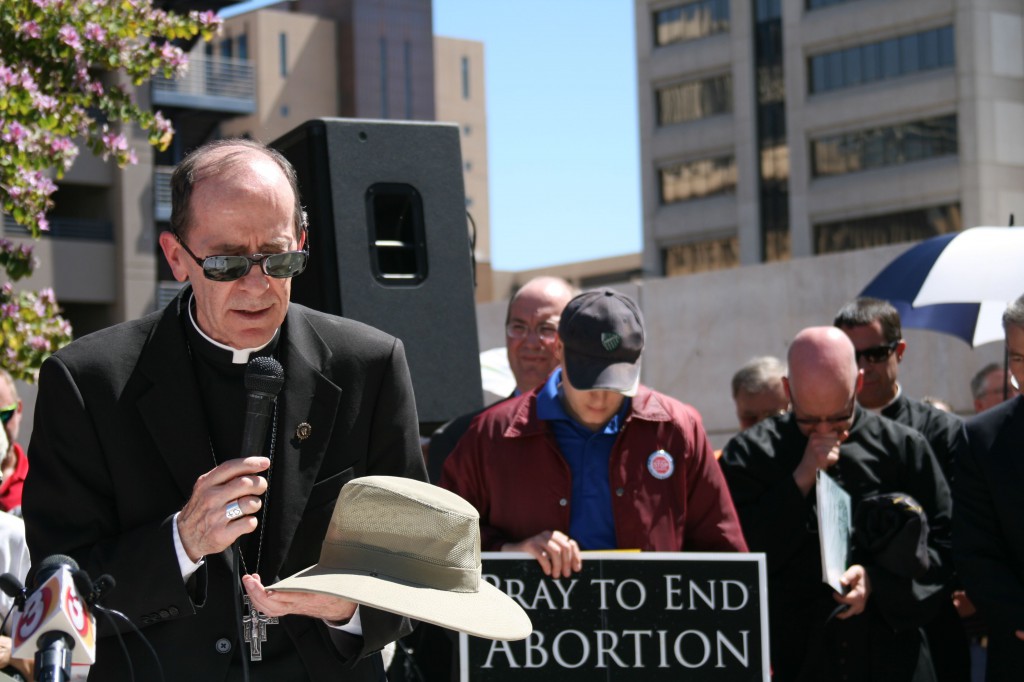
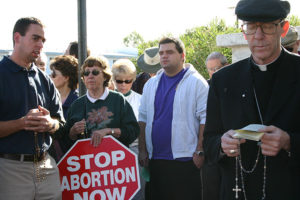
Building a culture of life
Sr. Jean left her position as chancellor of the diocese when her congregation, the Sisters of St. Agnes, asked her to be the general superior. Bishop Olmsted attended her installation in Wisconsin.
Sr. Jean described the bishop as a man who preaches from the heart, explaining that his message is “always filtered through prayer, study and love of Christ and the Church.”
Bishop Olmsted is well respected by his peers, she said, noting his involvement in many committees with the U.S. Conference of Catholic Bishops. Sr. Jean underscored the bishop’s service on Vox Clara, a Vatican committee established by the Congregation for Divine Worship and the Sacraments. The bishop serves as first vice chairman.
“He’s an extremely humble man,” she said. “Nothing that he does, does he do for glory. He does it out of love for the other.”
The bishop was reluctant to point to any particular accomplishment over the last 10 years — he doesn’t seem to think in such terms. He did say he was pleased with how the diocese is proclaiming the beauty of marriage, though he didn’t take credit for it.
The bishop noted the marriage preparation program, the ongoing formation through Natural Family Planning, the marriage conference, and the Catholic Academy for Life Leadership.
“Marriage and family are so vital for the Church and for society and so seriously threatened these days,” he said. “But, you know, God provided these people, they came here within the first three or four years of my being here. And Natural Family Planning has been here for decades before I even arrived.”
Mike Phelan, director of the Marriage and Respect Life Office, is one of those people God provided.
“Of course he didn’t take credit for it,” Phelan said. “But it’s because of his leadership. You can see the power of his episcopacy. We’re still fledgling, but there’s a definite movement to strengthen the domestic Church.”
Phelan noted that retired Bishop O’Brien had been a strong supporter of Natural Family Planning, allocating significant funding throughout his tenure. Bishop Olmsted built on that, requiring couples being married in the Catholic Church to take a full course of Natural Family Planning.
“The world doesn’t want to know what we have to say about human beings. They hate our anthropology,” Phelan said. “But the bishop knows these teachings will bring joy. He always says, ‘Trust the truth.’”
The bishop is also eager to support the pontificate of Pope Francis, according to Phelan. At a recent meeting on lay-led Catholic outreach, some grumbled that there were too many events going on and that it wasn’t well-coordinated.
In response, the bishop quoted Pope Francis from World Youth Day, Phelan said. The pope expected there would be a “a mess” or “noise” as the Church took its message “to the streets,” but so be it.
“I want us to resist everything worldly, everything static, everything comfortable, everything to do with clericalism, everything that might make us closed in on ourselves,” the pope said.
“The bishop doesn’t like a mess! He likes policy. He’s a canon lawyer,” Phelan said. “But he believes the Holy Spirit chose Francis and he will follow his lead, just like he followed Pope John Paul II and Pope Benedict XVI.”
Over the last 10 years, the bishop said he’s grown in his understanding of the Hispanic community and the gifts they bring. He noted the Catholic Association of Latino Leaders, which is chaired by local Catholic Tom Espinoza. The bishop also noted the first diocesan men’s conference organized in Spanish this year and other catechetical congresses being organized for the Hispanic community.
“A lot of things are blossoming” since the arrival of Auxiliary Bishop Eduardo A. Nevares in July 2010, Bishop Olmsted said. “That brings me great joy. I think that’s very much what the Holy Spirit wants to happen.”
Bishop Nevares called working with Bishop Olmsted “a privilege,” and said he was “a man who is able to trust his staff and delegates responsibilities to them.”
Bishop Nevares has said that while he admires the bishop’s prayer life, they definitely do not share the same exercise habits.
Bishop Olmsted loves to hike and loves nature. He will go on hikes with others, sometimes seminarians, and he prays the rosary and the Chaplet of Divine Mercy as he makes his way through the desert.
“In the summer, I’m out at 4:15 a.m., just as soon as you can see the rattlesnakes,” he said. “Because that’s the time that it’s cooler, you know, only 85 or 90 degrees.”
Little things
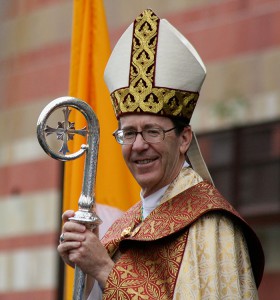
“The habit of my day has always pretty much been the same,” the bishop said. “That’s pretty much defined me wherever I am.”
Members of the Jesus Caritas fraternity commit to the Liturgy of the Hours, to a monthly day of silent retreat, and to a daily hour of adoration. It helps the bishop turn to Jesus throughout the day.
“For me I’ve always had a great attraction to prayer, to time with the Lord, to eucharistic adoration. It’s just a gift that’s been there since I was a little child,” the bishop said. “To live celibacy well, you need to have significant time with Jesus.”
“Little” is one of the bishop’s favorite words, he said. It was one of the favorite words of Blessed Charles de Foucauld. Several of the congregations inspired by the French priest have “little” in their title, like the Little Brothers of Jesus and the Little Sisters of the Gospel.
“Jesus made himself little,” the bishop said. “So if you come into my office, you see the child Jesus there on my little table. On the pillow of my bed, there’s always a little infant Jesus there.”
He explained that the many who followed Blessed Charles de Foucauld in Africa lived in Muslim areas. The depiction of the infant Jesus was instrumental to their evangelization.
“A lot of times those who do not know Christ will be frightened of the crucifix, but no one is frightened of a baby,” the bishop said.
An image of St. Michael the Archangel hangs on the wall of the bishop’s office at the cathedral rectory. He explained that in religious artwork, St. Michael is depicted either with a sword or a long, spindly lance. The image on his wall, and the depiction he prefers, is the slender lance.
“The lance looks so thin, as if it’s almost too weak to kill the dragon. But that’s what he does. So St. Michael, defend us in battle and all this, the strength doesn’t depend on us or even on our weapons, it depends on God, that’s one of the things we see here,” the bishop explained.
“I think we always feel like our weapons are too small or too weak, so I love that image of the St. Michael with the slender lance,” he added. “I think it’s an invitation to trust that God works even through weak instruments.”





